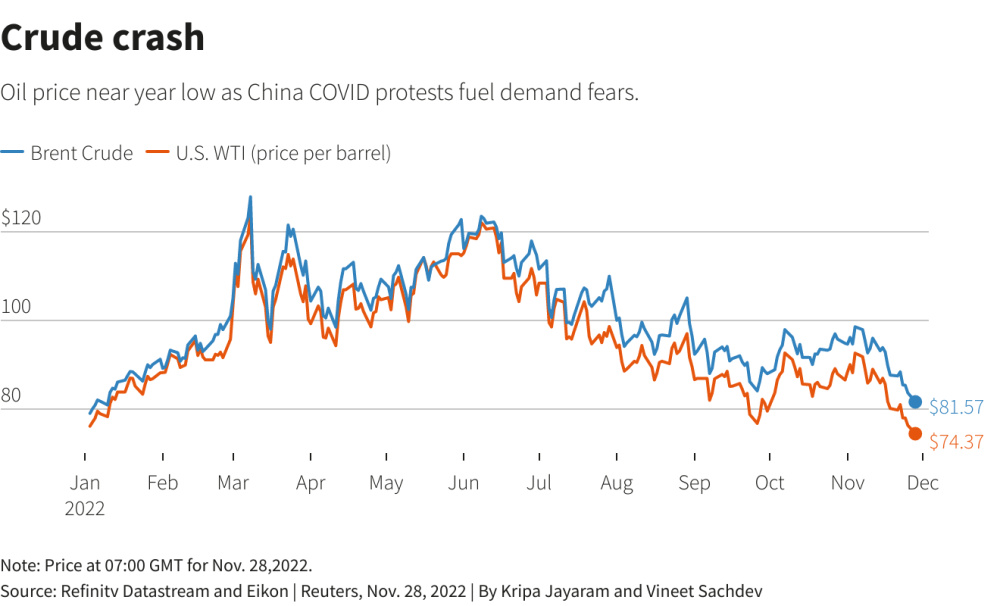U.S. crude turned positive and Brent pared losses on Nov. 28 after falling to close to their lowest levels in a year, as rumors of an OPEC+ production cut offset concerns about street protests against strict COVID-19 curbs in China, the world's biggest crude importer.
Price action was volatile. WTI crude in the U.S. rose 76 cents, or 1%, to $77.04 at 1:58 p.m. ET (1858 GMT), after touching its lowest since Dec. 22, 2021 at $73.60.
Brent crude also briefly turned positive, but was last down 47 cents, or 0.6%, at trade at $83.16 a barrel, having slumped more than 3% to $80.61 earlier in the session for its lowest since Jan. 4, 2022.
Both benchmarks, which hit 10-month lows last week, have posted three consecutive weekly declines.
“The word on the street is there’s rumor that OPEC+ is already starting to float the idea of a production cut on Sunday,” said Matt Smith, lead oil analyst at Kpler. “That’s helped reverse losses that were caused overnight by Chinese protests.”
OPEC and allies including Russia, a group known as OPEC+, will meet on Dec. 4. In October, OPEC+ agreed to reduce its output target by 2 million bbl/d through 2023.

Rumors of a possible cut outweighed an earlier sell-off on the news hundreds of demonstrators and police clashed in Shanghai on Nov. 27 as protests over COVID restrictions flared for a third day and spread to several cities.
China has stuck with President Xi Jinping’s zero-COVID policy even as much of the world has lifted most restrictions.
“We feel some of the selling based on reports of China uprisings was overdone,” said Phil Flynn, an analyst at Price Futures Group. “Inventories are still near record lows and this probably increases the odds of an OPEC production cut.”
RELATED:
What’s Affecting Oil Prices This Week? (Nov. 28, 2022)
Meanwhile, Group of Seven (G7) and EU diplomats have been discussing a price cap on Russian oil of between $65/bbl and $70/bbl, with the aim of limiting revenue to fund Moscow’s military offensive in Ukraine without disrupting global oil markets.
However, EU governments were split on the level at which to cap Russian oil prices, with the impact being potentially muted.
The price cap is due to come into effect on Dec. 5 when an EU ban on Russian crude also takes effect.
Recommended Reading
NOG Closes Utica Shale, Delaware Basin Acquisitions
2024-02-05 - Northern Oil and Gas’ Utica deal marks the entry of the non-op E&P in the shale play while it’s Delaware Basin acquisition extends its footprint in the Permian.
Vital Energy Again Ups Interest in Acquired Permian Assets
2024-02-06 - Vital Energy added even more working interests in Permian Basin assets acquired from Henry Energy LP last year at a purchase price discounted versus recent deals, an analyst said.
California Resources Corp., Aera Energy to Combine in $2.1B Merger
2024-02-07 - The announced combination between California Resources and Aera Energy comes one year after Exxon and Shell closed the sale of Aera to a German asset manager for $4 billion.
DXP Enterprises Buys Water Service Company Kappe Associates
2024-02-06 - DXP Enterprise’s purchase of Kappe, a water and wastewater company, adds scale to DXP’s national water management profile.
Tellurian Exploring Sale of Upstream Haynesville Shale Assets
2024-02-06 - Tellurian, which in November raised doubts about its ability to continue as a going concern, said cash from a divestiture would be used to pay off debt and finance the company’s Driftwood LNG project.





